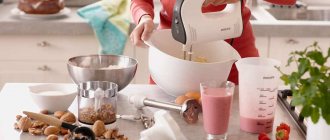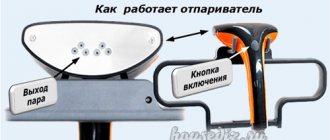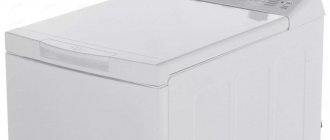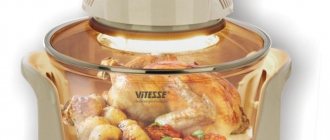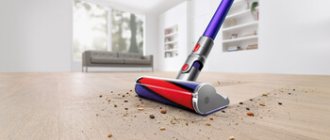It is easier for a housewife to prepare a dish if she has the appropriate kitchen appliances at hand. New electrical appliances for the kitchen are constantly appearing, which makes it more difficult to decide on what you need. In addition, some models may even have similar functions. So, there is still a struggle over the question of what is the difference between a mixer and a blender. These are English names for the technique, which are literally translated as “mix” and “prepare the mixture.” The article will help you decide for which cases a mixer is more suitable, and for which a blender, and how this technique will generally help in the kitchen.
What is the difference between a mixer and a blender?
A kitchen mixer is designed to beat soft ingredients into a homogeneous mass. Structurally, it consists of the following parts:
- housings with control elements;
- spacious bowl for ingredients;
- interchangeable attachments - wide whisks and hooks for kneading dough.
When using a mixer, the products are loaded into the bowl, and then the unit is put into operation. The nozzles move around their own axis, and in some models also around the circumference of the container along an orbital trajectory. Thanks to this, the highest quality whipping of sauces, creams and proteins is achieved without dense lumps.
The mixer allows you to prepare a large amount of cream in a short time
The design of a stationary blender looks a little different. The device consists of:
- the base on which the levers and buttons for turning on and configuring the unit are located;
- a tall glass for loading products;
- rotating steel knives at the bottom of the container, responsible for grinding the ingredients.
During operation, the products are also placed in the bowl, the device is closed, the required power is selected and the unit is put into operation. The blades cut ingredients into small pieces or puree them at high speed, depending on the setting and cycle time.
The main difference between a blender and a mixer lies in its purpose. The first unit works with products of any hardness and can crush vegetables, nuts and even pieces of ice. The second interacts only with soft and viscous ingredients and does not cut them, but stirs them until they become a thick, homogeneous mass.
What is the difference between an immersion blender and a mixer?
Kitchen blenders are not only stationary, but also submersible. The latter consist of a grinding glass and a handle with a long metal “leg” and sharp knives in its lower part.
By default, when using a submersible unit, you need to load the products into the bowl, close the lid, and then install the main nozzle on top and put the device into operation. However, if desired, the device can grind the ingredients in any deep container - in a bowl, pan, plastic container.
Most often, submersible devices are equipped with an additional attachment - a metal or plastic whisk for whipping soft products. This gives them a certain resemblance to mixers. However, important differences remain between the instruments. In terms of power, an immersion blender is noticeably inferior to a stationary mixer and provides less quality whipping.
Some mixers can be removed from the base and used manually, like immersion blenders
Advantages and disadvantages of devices
Manual and stationary mixer models are famous for such advantages as:
- quick and convenient whipping of liquid ingredients;
- the ability to create airy mousses and lush mixtures;
- ergonomics, mobility and light weight;
- no need for special maintenance;
- acceptable price.
Among the disadvantages of the mixer are the inability to grind solid products and slight heating of the body during operation.
Unlike a mixer, a blender has advanced functionality and a more modern design.
Keep in mind! The device has other advantages, including:
- versatility of use;
- availability of additional attachments;
- ability to grind hard products;
- high productivity and efficiency;
- convenient control panel.
the disadvantages of advanced blenders :
- higher cost;
- dimensions of the structure;
- work with a higher level of sound.
What is better for whipping - a blender or a mixer?
The mixer is intended for mixing soft foods only and is not suitable for chopping hard fruits and vegetables. Its functionality is limited, but a blender can usually handle both tough and viscous ingredients.
At first glance, the latter device may seem more convenient and profitable. But before buying, you need to pay attention to the nuances.
What is better to beat the cream - with a mixer or blender?
Soft cream for cakes and pastries should have the most delicate and uniform structure without inclusions. It is recommended to use a mixer for preparation. Its whisks have optimal sizes and shapes, are made of high-quality solid material and easily cope with whipping the creamy mass.
When using a blender with a special attachment, the result is of less quality. The cream remains not entirely homogeneous and does not have the same light and delicate structure. Professional confectioners need to use specialized equipment to prepare desserts.
Advice! It is recommended to beat the cream with a blender if you need to process a small amount of product. The device can become more convenient, since the mixing attachments often do not reach the bottom of the bowl.
What is better to beat egg whites - with a mixer or blender?
It is recommended to use a kitchen mixer to beat egg whites; it allows you to achieve an airy and uniform structure during processing. To obtain a quality product you must:
- Break well-chilled eggs, separate the whites from the yolks and pour them into a dry bowl.
- Beat the product at low speed for two minutes.
- Increase power to medium and process egg whites for another two minutes.
- Set the device to maximum speed and continue whipping until you obtain a fluffy foam with soft peaks.
It is usually impossible to repeat the procedure using a blender, since its whisk has a different shape, is made of less rigid materials, and, moreover, not all models support switching speeds. It is worth using the unit only if a specialized device is not at hand, and the only available alternative is manual kneading of proteins.
Metal blender whisks do a better job of blending than plastic ones.
The best way to whip cream and mayonnaise is with a mixer or blender.
As in previous cases, when preparing homemade mayonnaise and cream, you need to take into account the differences between a blender and a mixer. The last unit is better suited for whipping soft ingredients; it allows you to start processing at low speed, and then gradually increase the speed. As a result, the cream and mayonnaise turns out no worse than from the store.
You can also use a blender with a whisk, but the preparation will take longer and the consistency will be less uniform. In the absence of a special attachment for whipping, the device will not cope with mixing mayonnaise or cream at all; chopping knives will not allow you to achieve the desired effect.
What is better to beat the puree - with a mixer or blender?
Mixers are definitely better at processing soft semi-liquid components. But to make puree you need to use a blender.
Mixing hooks and whisks are not designed for chopping dense boiled potatoes. And even if you load already prepared soft mass into the bowl of the device in order to rid it of the remaining lumps, the device will still not cope well with the task.
As for the blender, it is suitable for the full cycle of processing boiled potatoes; sharply sharpened knives cope with chopping products without any problems. Many models of equipment come with a special attachment for purees, which contains not only blades, but also frequent round holes for pushing through dense masses. The finished product is homogeneous and without lumps.
Using a blender with a special attachment, you can puree any boiled vegetables.
conclusions
When choosing between a mixer and a blender, it is important to remember the following nuances:
- a hand mixer is suitable for simple tasks , but a stationary one will help you prepare a large number of different dishes;
- for cooking solid foods, it is better to choose a blender - it is much more functional, but its cost is slightly higher;
- the main technical parameters of the devices are power consumption and the number of operating speeds ;
- special attention must be paid to the safety system, quality of materials and workmanship, as well as the number of replaceable nozzles;
- For convenient use, you should give preference to a model with a long power cord.
Reviews about which is better - a blender or a mixer
Fomina Anna Vitalievna, 29 years old, Yekaterinburg
After the birth of my child, I realized that I didn’t want to spend extra time in the kitchen, manually mashing boiled vegetables for puree. For some time I was unsure whether to buy a blender or a mixer - the latter seemed more functional. But I read the reviews and realized that specifically for my purposes I needed a device with high-quality grinding. I bought an immersion blender, it prepares puree perfectly, and the included whisk helps from time to time whip cream or cream for desserts.
Petrakova Irina Sergeevna, 37 years old, Moscow
I’ve been making custom cakes and pastries for a year now, and I recently bought my first mixer. It cost me quite a lot, but the benefits became noticeable immediately - the creams and whites turned out very airy and tender. Previously, I whipped them with a blender, spending a lot of extra time to achieve the desired consistency. The new device has made life much easier, and I get more pleasure from cooking.
Comparisons and differences
The table shows the difference between a mixer and a blender.
| Operation to be performed | Blender | Mixer |
| Batter | + | + |
| Dough with the consistency of thick sour cream | + | + |
| Pie dough | — | + |
| Beating egg whites | — | + |
| Preparing mayonnaise | — | + |
| Grinding nuts and crackers | + | — |
| Ice crushing | + | — |
Manual analogues
Hand whisking is the easiest way to replace the mixer. To obtain the desired consistency of the ingredients being prepared, use:
- an ordinary whisk;
- table fork;
- glass jar and a lid under it.
The principle of using a fork and a whisk is the same, you just need to beat the ingredients with your hands. The main disadvantage is that you cannot manually reach the mixer speed.
It is necessary to speed up your hand movements as much as possible. This method will be sufficient for whipping protein cream and butter.
Using a jar is slightly different.
- Place the ingredients in the jar.
- Close it tightly with the lid.
- Start shaking the contents as fast as possible.
- Within 5 minutes you can achieve the desired result.
Choosing the right products for cream cheese
The key to a perfect dessert is high-quality and fresh ingredients. To make real cheese cream, only cream cheeses with a delicate creamy consistency and light flavor notes of cream and cheese are suitable. The most common brands are Philadelphia and Mascarpone; they are made from natural cream and milk with additives that cause curdling.
Cottage cheese, processed cream cheeses and whey-based Ricotta cheese are not used for production. Condensed milk with sugar in recipes uses classic and boiled milk, made according to GOST.
Now let's move on to the models
We'll start with mixers that have a bowl
MOULINEX HM 41213E
The model is interesting with its good power, which is enough for kneading dough and whipping anything, with a rotating bowl, which is made of high-quality plastic; choice of up to five speeds; turbo mode; a good rubberized handle that allows you to hold it comfortably and securely in your hand; possibility of removing the mixer stand with bowl. Accordingly, the mixer can be used separately.
BOSCH MFQ 36460
This mixer is good, like the previous model, but the plastic is already white. This model is easy to hold in your hand and switches speeds, moves smoothly and is not loud.
Now let's look at a mixer without a bowl
The model is notable for the fact that, unlike the model with a bowl, it has less power, but the performance is the same. Four speeds, turbo mode, which will allow you to quickly finish the mixtures or kneading dough if you are running out of time. Oh, yes, I forgot to add that such models are assembled not in China, but in Europe.
